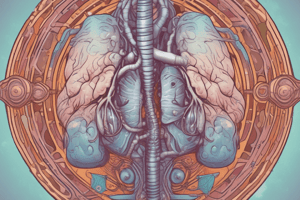Podcast
Questions and Answers
A patient presents with a fever, cough, and pleuritic chest pain, but has had no contact with medical institutions. Based on the likely causative organisms for community-acquired pneumonia, which diagnostic test would be LEAST helpful in determining the etiology of the patient's condition?
A patient presents with a fever, cough, and pleuritic chest pain, but has had no contact with medical institutions. Based on the likely causative organisms for community-acquired pneumonia, which diagnostic test would be LEAST helpful in determining the etiology of the patient's condition?
- Serological test for _Mycoplasma pneumoniae_.
- Rapid antigen test for influenza viruses.
- Blood culture for _Staphylococcus aureus_. (correct)
- Sputum culture for _Streptococcus pneumoniae_.
A 6-year-old child is diagnosed with community-acquired pneumonia and requires inpatient treatment. Considering the recommended treatment guidelines, which of the following antibiotic regimens would be the MOST appropriate initial therapy?
A 6-year-old child is diagnosed with community-acquired pneumonia and requires inpatient treatment. Considering the recommended treatment guidelines, which of the following antibiotic regimens would be the MOST appropriate initial therapy?
- Ceftriaxone 50 mg/kg IV once daily.
- Clarithromycin 500 mg orally twice daily.
- Erythromycin 10 mg/kg IV every 6 hours.
- Cefuroxime 50 mg/kg IV every 8 hours. (correct)
A patient diagnosed with community-acquired pneumonia is prescribed erythromycin. Which of the following mechanisms of action is responsible for erythromycin's effects on susceptible bacteria?
A patient diagnosed with community-acquired pneumonia is prescribed erythromycin. Which of the following mechanisms of action is responsible for erythromycin's effects on susceptible bacteria?
- Inhibition of cell wall synthesis.
- Inhibition of folic acid metabolism.
- Disruption of bacterial protein synthesis. (correct)
- Interference with DNA replication.
An 8-year-old child is diagnosed with community-acquired pneumonia. The child is treated as an outpatient. Which of the following antibiotic regimens would be MOST appropriate?
An 8-year-old child is diagnosed with community-acquired pneumonia. The child is treated as an outpatient. Which of the following antibiotic regimens would be MOST appropriate?
A 5-year-old child is diagnosed with community-acquired pneumonia. The physician is considering prescribing erythromycin. What is the most important factor the physician should consider before prescribing erythromycin?
A 5-year-old child is diagnosed with community-acquired pneumonia. The physician is considering prescribing erythromycin. What is the most important factor the physician should consider before prescribing erythromycin?
A 4-year-old child is diagnosed with community-acquired pneumonia. The child is prescribed erythromycin as an outpatient. The parent asks how to administer the medication. What is the most appropriate advice?
A 4-year-old child is diagnosed with community-acquired pneumonia. The child is prescribed erythromycin as an outpatient. The parent asks how to administer the medication. What is the most appropriate advice?
While determining the treatment plan for a 2-year-old with community-acquired pneumonia, the physician notices the child has watery rhinorrhea, sneezing, and a low-grade fever, in addition to respiratory distress. Which causative organism is MOST likely?
While determining the treatment plan for a 2-year-old with community-acquired pneumonia, the physician notices the child has watery rhinorrhea, sneezing, and a low-grade fever, in addition to respiratory distress. Which causative organism is MOST likely?
A previously healthy 10-year-old child is diagnosed with community-acquired pneumonia. The child is allergic to macrolides. Considering this allergy, which alternative antibiotic would be MOST appropriate for outpatient treatment?
A previously healthy 10-year-old child is diagnosed with community-acquired pneumonia. The child is allergic to macrolides. Considering this allergy, which alternative antibiotic would be MOST appropriate for outpatient treatment?
An 80-year-old patient is admitted to the hospital with community-acquired pneumonia. The patient has a history of multiple comorbidities, including chronic obstructive pulmonary disease (COPD) and heart failure, and is currently on several medications. Which of the following factors should be MOST carefully considered to determine the appropriate dose?
An 80-year-old patient is admitted to the hospital with community-acquired pneumonia. The patient has a history of multiple comorbidities, including chronic obstructive pulmonary disease (COPD) and heart failure, and is currently on several medications. Which of the following factors should be MOST carefully considered to determine the appropriate dose?
A 16-year-old is diagnosed with community-acquired pneumonia. They are treated as an outpatient with azithromycin. What is the MOST important communication point about this prescription?
A 16-year-old is diagnosed with community-acquired pneumonia. They are treated as an outpatient with azithromycin. What is the MOST important communication point about this prescription?
Flashcards
Community-acquired Pneumonia
Community-acquired Pneumonia
Pneumonia acquired by individuals with little to no contact with medical facilities.
Common CAP Organisms
Common CAP Organisms
S. pneumoniae, H. influenzae, and viruses like RSV and influenza are common causes.
CAP Manifestations
CAP Manifestations
Fever, cough, chest pain, dyspnea, tachypnea, and tachycardia.
CAP Treatment
CAP Treatment
Signup and view all the flashcards
Study Notes
Community-Acquired Pneumonia (CAP)
- Community-acquired pneumonia occurs in people without recent exposure to medical facilities.
- Streptococcus pneumoniae, Haemophilus influenzae, Chlamydia pneumoniae, Mycoplasma pneumoniae, Legionella species, respiratory syncytial virus (RSV), adenovirus, influenza viruses, metapneumovirus, and parainfluenza viruses are causative organisms.
- Symptoms include fever, cough, pleuritic chest pain, dyspnea, tachypnea, and tachycardia.
CAP Treatment
- For 0-3 week olds, treatment involves ampicillin or nafcillin plus gentamicin or cefotaxime.
- For 3 weeks to 3 months old treatment:
- Outpatient care: erythromycin 10 mg/kg IV every 6 hours for 10-14 days.
- Inpatient care: cefuroxime 50 mg/kg IV every 8-12 hours.
- ICU: cefotaxime 66 mg/kg IV three times daily and cloxacillin 50 mg/kg IV every 6 hours.
- For 4 months to 4 years old treatment:
- Outpatient care: erythromycin 10 mg/kg IV four times daily.
- Inpatient care: erythromycin 10 mg/kg orally four times daily and cefuroxime 50 mg/kg IV every 8 hours.
- For 5-15 year olds treatment:
- Outpatient care: clarithromycin 500 mg orally twice daily.
- Inpatient care: ceftriaxone 50 mg/kg IV once daily (maximum 2g) and azithromycin 10 mg/kg once daily (maximum 500 mg).
Studying That Suits You
Use AI to generate personalized quizzes and flashcards to suit your learning preferences.



